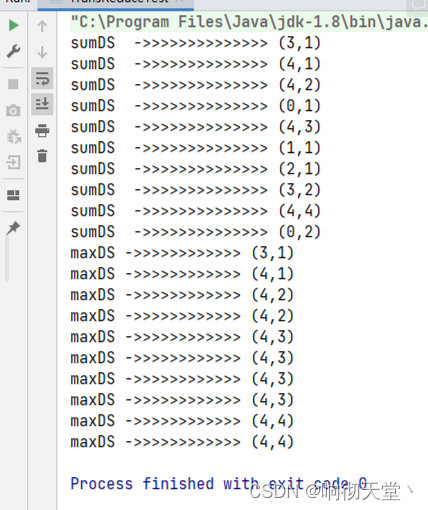如果说简单聚合是对一些特定统计需求的实现,那么 reduce 算子就是一个一般化的聚合统计操作了。从大名鼎鼎的 MapReduce 开始,我们对 reduce 操作就不陌生:它可以对已有的
数据进行归约处理,把每一个新输入的数据和当前已经归约出来的值,再做一个聚合计算。与简单聚合类似,reduce 操作也会将 KeyedStream 转换为 DataStream。它不会改变流的元
素数据类型,所以输出类型和输入类型是一样的。调用 KeyedStream 的 reduce 方法时,需要传入一个参数,实现 ReduceFunction 接口。接口在源码中的定义如下:
@Public@FunctionalInterfacepublicinterfaceReduceFunction<T>extendsFunction,Serializable{/**
* The core method of ReduceFunction, combining two values into one value of the same type. The
* reduce function is consecutively applied to all values of a group until only a single value
* remains.
*
* @param value1 The first value to combine.
* @param value2 The second value to combine.
* @return The combined value of both input values.
* @throws Exception This method may throw exceptions. Throwing an exception will cause the
* operation to fail and may trigger recovery.
*/Treduce(T value1,T value2)throwsException;}
ReduceFunction 接口里需要实现 reduce()方法,这个方法接收两个输入事件,经过转换处理之后输出一个相同类型的事件;所以,对于一组数据,我们可以先取两个进行合并,然后再
将合并的结果看作一个数据、再跟后面的数据合并,最终会将它“简化”成唯一的一个数据,这也就是 reduce“归约”的含义。在流处理的底层实现过程中,实际上是将中间“合并的结果”
作为任务的一个状态保存起来的;之后每来一个新的数据,就和之前的聚合状态进一步做归约。
其实,reduce 的语义是针对列表进行规约操作,运算规则由 ReduceFunction 中的 reduce方法来定义,而在 ReduceFunction 内部会维护一个初始值为空的累加器,注意累加器的类型
和输入元素的类型相同,当第一条元素到来时,累加器的值更新为第一条元素的值,当新的元素到来时,新元素会和累加器进行累加操作,这里的累加操作就是 reduce 函数定义的运算规
则。然后将更新以后的累加器的值向下游输出。
我们可以单独定义一个函数类实现 ReduceFunction 接口,也可以直接传入一个匿名类。当然,同样也可以通过传入 Lambda 表达式实现类似的功能。与简单聚合类似,reduce 操作也会将 KeyedStream 转换为 DataStrema。它不会改变流的元素数据类型,所以输出类型和输入类型是一样的。下面我们来看一个稍复杂的例子。
我们将数据流按照用户 id 进行分区,然后用一个 reduce 算子实现 sum 的功能,统计每个用户访问的频次;进而将所有统计结果分到一组,用另一个 reduce 算子实现 maxBy 的功能,记录所有用户中访问频次最高的那个,也就是当前访问量最大的用户是谁。
packagecom.rosh.flink.test;importorg.apache.flink.api.common.functions.MapFunction;importorg.apache.flink.api.common.functions.ReduceFunction;importorg.apache.flink.api.java.tuple.Tuple2;importorg.apache.flink.streaming.api.datastream.DataStreamSource;importorg.apache.flink.streaming.api.datastream.SingleOutputStreamOperator;importorg.apache.flink.streaming.api.environment.StreamExecutionEnvironment;importjava.util.ArrayList;importjava.util.List;importjava.util.Random;/**
* 我们将数据流按照用户 id 进行分区,然后用一个 reduce 算子实现 sum 的功能,统计每个
* 用户访问的频次;进而将所有统计结果分到一组,用另一个 reduce 算子实现 maxBy 的功能,
* 记录所有用户中访问频次最高的那个,也就是当前访问量最大的用户是谁。
*/publicclassTransReduceTest{publicstaticvoidmain(String[] args)throwsException{StreamExecutionEnvironment env =StreamExecutionEnvironment.getExecutionEnvironment();
env.setParallelism(1);//随机生成数据Random random =newRandom();List<Integer> userIds =newArrayList<>();for(int i =1; i <=10; i++){
userIds.add(random.nextInt(5));}DataStreamSource<Integer> userIdDS = env.fromCollection(userIds);//每个ID访问记录一次SingleOutputStreamOperator<Tuple2<Integer,Long>> mapDS = userIdDS.map(newMapFunction<Integer,Tuple2<Integer,Long>>(){@OverridepublicTuple2<Integer,Long>map(Integer value)throwsException{returnnewTuple2<>(value,1L);}});//统计每个user访问多少次SingleOutputStreamOperator<Tuple2<Integer,Long>> sumDS = mapDS.keyBy(tuple -> tuple.f0).reduce(newReduceFunction<Tuple2<Integer,Long>>(){@OverridepublicTuple2<Integer,Long>reduce(Tuple2<Integer,Long> value1,Tuple2<Integer,Long> value2)throwsException{returnnewTuple2<>(value1.f0, value1.f1 + value2.f1);}});
sumDS.print("sumDS ->>>>>>>>>>>>>");//把所有分区合并,求出最大的访问量SingleOutputStreamOperator<Tuple2<Integer,Long>> maxDS = sumDS.keyBy(key ->true).reduce(newReduceFunction<Tuple2<Integer,Long>>(){@OverridepublicTuple2<Integer,Long>reduce(Tuple2<Integer,Long> value1,Tuple2<Integer,Long> value2)throwsException{if(value1.f1 > value2.f1){return value1;}else{return value2;}}});
maxDS.print("maxDS ->>>>>>>>>>>");
env.execute("TransReduceTest");}}

版权归原作者 响彻天堂丶 所有, 如有侵权,请联系我们删除。